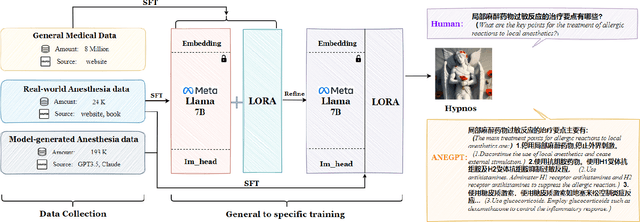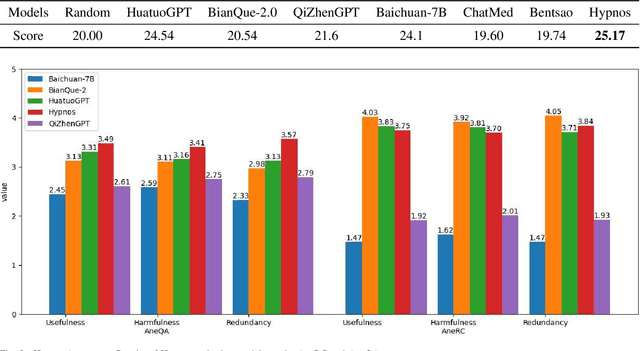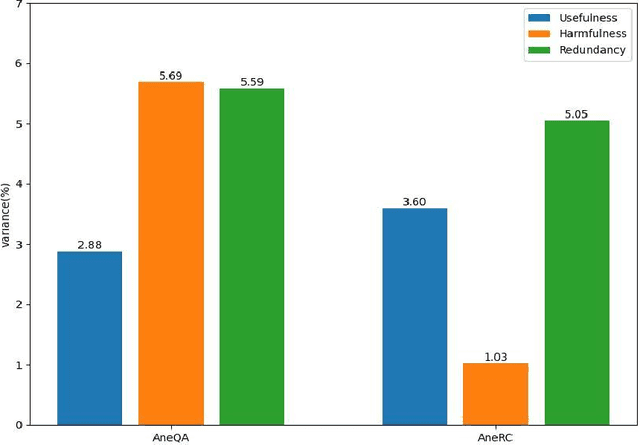Weifeng Liu
Flexible Operator Fusion for Fast Sparse Transformer with Diverse Masking on GPU
Jun 06, 2025Abstract:Large language models are popular around the world due to their powerful understanding capabilities. As the core component of LLMs, accelerating Transformer through parallelization has gradually become a hot research topic. Mask layers introduce sparsity into Transformer to reduce calculations. However, previous works rarely focus on the performance optimization of sparse Transformer. Moreover, rule-based mechanisms ignore the fusion opportunities of mixed-type operators and fail to adapt to various sequence lengths. To address the above problems, we propose STOF, a framework that incorporates optimizations for Sparse Transformer via flexible masking and operator fusion on GPU. We firstly unify the storage format and kernel implementation for the multi-head attention. Then, we map fusion schemes to compilation templates and determine the optimal parameter setting through a two-stage search engine. The experimental results show that compared to the state-of-the-art work, STOF achieves maximum speedups of 1.7x in MHA computation and 1.5x in end-to-end inference.
FFCBA: Feature-based Full-target Clean-label Backdoor Attacks
Apr 29, 2025Abstract:Backdoor attacks pose a significant threat to deep neural networks, as backdoored models would misclassify poisoned samples with specific triggers into target classes while maintaining normal performance on clean samples. Among these, multi-target backdoor attacks can simultaneously target multiple classes. However, existing multi-target backdoor attacks all follow the dirty-label paradigm, where poisoned samples are mislabeled, and most of them require an extremely high poisoning rate. This makes them easily detectable by manual inspection. In contrast, clean-label attacks are more stealthy, as they avoid modifying the labels of poisoned samples. However, they generally struggle to achieve stable and satisfactory attack performance and often fail to scale effectively to multi-target attacks. To address this issue, we propose the Feature-based Full-target Clean-label Backdoor Attacks (FFCBA) which consists of two paradigms: Feature-Spanning Backdoor Attacks (FSBA) and Feature-Migrating Backdoor Attacks (FMBA). FSBA leverages class-conditional autoencoders to generate noise triggers that align perturbed in-class samples with the original category's features, ensuring the effectiveness, intra-class consistency, inter-class specificity and natural-feature correlation of triggers. While FSBA supports swift and efficient attacks, its cross-model attack capability is relatively weak. FMBA employs a two-stage class-conditional autoencoder training process that alternates between using out-of-class samples and in-class samples. This allows FMBA to generate triggers with strong target-class features, making it highly effective for cross-model attacks. We conduct experiments on multiple datasets and models, the results show that FFCBA achieves outstanding attack performance and maintains desirable robustness against the state-of-the-art backdoor defenses.
CoCo-Bench: A Comprehensive Code Benchmark For Multi-task Large Language Model Evaluation
Apr 29, 2025Abstract:Large language models (LLMs) play a crucial role in software engineering, excelling in tasks like code generation and maintenance. However, existing benchmarks are often narrow in scope, focusing on a specific task and lack a comprehensive evaluation framework that reflects real-world applications. To address these gaps, we introduce CoCo-Bench (Comprehensive Code Benchmark), designed to evaluate LLMs across four critical dimensions: code understanding, code generation, code modification, and code review. These dimensions capture essential developer needs, ensuring a more systematic and representative evaluation. CoCo-Bench includes multiple programming languages and varying task difficulties, with rigorous manual review to ensure data quality and accuracy. Empirical results show that CoCo-Bench aligns with existing benchmarks while uncovering significant variations in model performance, effectively highlighting strengths and weaknesses. By offering a holistic and objective evaluation, CoCo-Bench provides valuable insights to guide future research and technological advancements in code-oriented LLMs, establishing a reliable benchmark for the field.
SFIBA: Spatial-based Full-target Invisible Backdoor Attacks
Apr 29, 2025Abstract:Multi-target backdoor attacks pose significant security threats to deep neural networks, as they can preset multiple target classes through a single backdoor injection. This allows attackers to control the model to misclassify poisoned samples with triggers into any desired target class during inference, exhibiting superior attack performance compared with conventional backdoor attacks. However, existing multi-target backdoor attacks fail to guarantee trigger specificity and stealthiness in black-box settings, resulting in two main issues. First, they are unable to simultaneously target all classes when only training data can be manipulated, limiting their effectiveness in realistic attack scenarios. Second, the triggers often lack visual imperceptibility, making poisoned samples easy to detect. To address these problems, we propose a Spatial-based Full-target Invisible Backdoor Attack, called SFIBA. It restricts triggers for different classes to specific local spatial regions and morphologies in the pixel space to ensure specificity, while employing a frequency-domain-based trigger injection method to guarantee stealthiness. Specifically, for injection of each trigger, we first apply fast fourier transform to obtain the amplitude spectrum of clean samples in local spatial regions. Then, we employ discrete wavelet transform to extract the features from the amplitude spectrum and use singular value decomposition to integrate the trigger. Subsequently, we selectively filter parts of the trigger in pixel space to implement trigger morphology constraints and adjust injection coefficients based on visual effects. We conduct experiments on multiple datasets and models. The results demonstrate that SFIBA can achieve excellent attack performance and stealthiness, while preserving the model's performance on benign samples, and can also bypass existing backdoor defenses.
Modeling All Response Surfaces in One for Conditional Search Spaces
Jan 08, 2025Abstract:Bayesian Optimization (BO) is a sample-efficient black-box optimizer commonly used in search spaces where hyperparameters are independent. However, in many practical AutoML scenarios, there will be dependencies among hyperparameters, forming a conditional search space, which can be partitioned into structurally distinct subspaces. The structure and dimensionality of hyperparameter configurations vary across these subspaces, challenging the application of BO. Some previous BO works have proposed solutions to develop multiple Gaussian Process models in these subspaces. However, these approaches tend to be inefficient as they require a substantial number of observations to guarantee each GP's performance and cannot capture relationships between hyperparameters across different subspaces. To address these issues, this paper proposes a novel approach to model the response surfaces of all subspaces in one, which can model the relationships between hyperparameters elegantly via a self-attention mechanism. Concretely, we design a structure-aware hyperparameter embedding to preserve the structural information. Then, we introduce an attention-based deep feature extractor, capable of projecting configurations with different structures from various subspaces into a unified feature space, where the response surfaces can be formulated using a single standard Gaussian Process. The empirical results on a simulation function, various real-world tasks, and HPO-B benchmark demonstrate that our proposed approach improves the efficacy and efficiency of BO within conditional search spaces.
Rethinking Prior Information Generation with CLIP for Few-Shot Segmentation
May 14, 2024Abstract:Few-shot segmentation remains challenging due to the limitations of its labeling information for unseen classes. Most previous approaches rely on extracting high-level feature maps from the frozen visual encoder to compute the pixel-wise similarity as a key prior guidance for the decoder. However, such a prior representation suffers from coarse granularity and poor generalization to new classes since these high-level feature maps have obvious category bias. In this work, we propose to replace the visual prior representation with the visual-text alignment capacity to capture more reliable guidance and enhance the model generalization. Specifically, we design two kinds of training-free prior information generation strategy that attempts to utilize the semantic alignment capability of the Contrastive Language-Image Pre-training model (CLIP) to locate the target class. Besides, to acquire more accurate prior guidance, we build a high-order relationship of attention maps and utilize it to refine the initial prior information. Experiments on both the PASCAL-5{i} and COCO-20{i} datasets show that our method obtains a clearly substantial improvement and reaches the new state-of-the-art performance.
Adaptive Bidirectional Displacement for Semi-Supervised Medical Image Segmentation
May 01, 2024Abstract:Consistency learning is a central strategy to tackle unlabeled data in semi-supervised medical image segmentation (SSMIS), which enforces the model to produce consistent predictions under the perturbation. However, most current approaches solely focus on utilizing a specific single perturbation, which can only cope with limited cases, while employing multiple perturbations simultaneously is hard to guarantee the quality of consistency learning. In this paper, we propose an Adaptive Bidirectional Displacement (ABD) approach to solve the above challenge. Specifically, we first design a bidirectional patch displacement based on reliable prediction confidence for unlabeled data to generate new samples, which can effectively suppress uncontrollable regions and still retain the influence of input perturbations. Meanwhile, to enforce the model to learn the potentially uncontrollable content, a bidirectional displacement operation with inverse confidence is proposed for the labeled images, which generates samples with more unreliable information to facilitate model learning. Extensive experiments show that ABD achieves new state-of-the-art performances for SSMIS, significantly improving different baselines. Source code is available at https://github.com/chy-upc/ABD.
Let Real Images be as a Judger, Spotting Fake Images Synthesized with Generative Models
Mar 25, 2024Abstract:In the last few years, generative models have shown their powerful capabilities in synthesizing realistic images in both quality and diversity (i.e., facial images, and natural subjects). Unfortunately, the artifact patterns in fake images synthesized by different generative models are inconsistent, leading to the failure of previous research that relied on spotting subtle differences between real and fake. In our preliminary experiments, we find that the artifacts in fake images always change with the development of the generative model, while natural images exhibit stable statistical properties. In this paper, we employ natural traces shared only by real images as an additional predictive target in the detector. Specifically, the natural traces are learned from the wild real images and we introduce extended supervised contrastive learning to bring them closer to real images and further away from fake ones. This motivates the detector to make decisions based on the proximity of images to the natural traces. To conduct a comprehensive experiment, we built a high-quality and diverse dataset that includes generative models comprising 6 GAN and 6 diffusion models, to evaluate the effectiveness in generalizing unknown forgery techniques and robustness in surviving different transformations. Experimental results show that our proposed method gives 96.1% mAP significantly outperforms the baselines. Extensive experiments conducted on the widely recognized platform Midjourney reveal that our proposed method achieves an accuracy exceeding 78.4%, underscoring its practicality for real-world application deployment. The source code and partial self-built dataset are available in supplementary material.
Building Accurate Translation-Tailored LLMs with Language Aware Instruction Tuning
Mar 21, 2024Abstract:Translation-tailored Large language models (LLMs) exhibit remarkable translation capabilities, even competing with supervised-trained commercial translation systems. However, off-target translation remains an unsolved problem, especially for low-resource languages, hindering us from developing accurate LLMs-based translation models. To mitigate the off-target translation problem and enhance the performance of LLMs on translation, recent works have either designed advanced prompting strategies to highlight the functionality of translation instructions or exploited the in-context learning ability of LLMs by feeding few-shot demonstrations. However, these methods essentially do not improve LLM's ability to follow translation instructions, especially the language direction information. In this work, we design a two-stage fine-tuning algorithm to improve the instruction-following ability (especially the translation direction) of LLMs. Specifically, we first tune LLMs with the maximum likelihood estimation loss on the translation dataset to elicit the basic translation capabilities. In the second stage, we construct instruction-conflicting samples by randomly replacing the translation directions with a wrong one within the instruction, and then introduce an extra unlikelihood loss to learn those samples. Experiments on IWSLT and WMT benchmarks upon the LLaMA model spanning 16 zero-shot directions show that, compared to the competitive baseline -- translation-finetuned LLama, our method could effectively reduce the off-target translation ratio (averagely -53.3\%), thus improving translation quality with average +5.7 SacreBLEU and +16.4 BLEURT. Analysis shows that our method could preserve the model's general task performance on AlpacaEval. Code and models will be released at \url{https://github.com/alphadl/LanguageAware_Tuning}.
Towards Training A Chinese Large Language Model for Anesthesiology
Mar 05, 2024



Abstract:Medical large language models (LLMs) have gained popularity recently due to their significant practical utility. However, most existing research focuses on general medicine, and there is a need for in-depth study of LLMs in specific fields like anesthesiology. To fill the gap, we introduce Hypnos, a Chinese Anesthesia model built upon existing LLMs, e.g., Llama. Hypnos' contributions have three aspects: 1) The data, such as utilizing Self-Instruct, acquired from current LLMs likely includes inaccuracies. Hypnos implements a cross-filtering strategy to improve the data quality. This strategy involves using one LLM to assess the quality of the generated data from another LLM and filtering out the data with low quality. 2) Hypnos employs a general-to-specific training strategy that starts by fine-tuning LLMs using the general medicine data and subsequently improving the fine-tuned LLMs using data specifically from Anesthesiology. The general medical data supplement the medical expertise in Anesthesiology and enhance the effectiveness of Hypnos' generation. 3) We introduce a standardized benchmark for evaluating medical LLM in Anesthesiology. Our benchmark includes both publicly available instances from the Internet and privately obtained cases from the Hospital. Hypnos outperforms other medical LLMs in anesthesiology in metrics, GPT-4, and human evaluation on the benchmark dataset.
 Add to Chrome
Add to Chrome Add to Firefox
Add to Firefox Add to Edge
Add to Edge